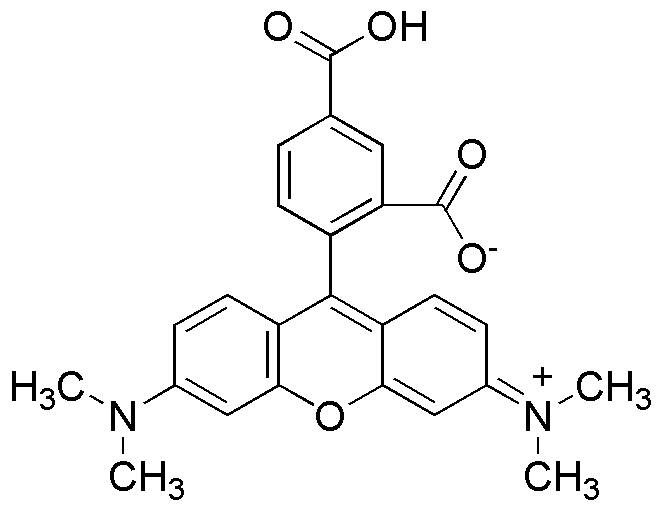5-Carboxy-tetramethylrhodamine is widely utilized in research focused on:
- Fluorescent Labeling: This compound is commonly used as a fluorescent dye in biological research, allowing scientists to tag and visualize proteins and other biomolecules in live cells.
- Imaging Techniques: It plays a crucial role in advanced imaging techniques such as fluorescence microscopy, providing high-resolution images that help researchers study cellular processes in detail.
- Flow Cytometry: The compound is employed in flow cytometry applications, enabling the analysis of cell populations based on their fluorescent characteristics, which is vital in immunology and cancer research.
- Drug Development: In pharmaceutical research, it aids in tracking drug delivery and distribution within biological systems, enhancing the understanding of pharmacokinetics and drug efficacy.
- Environmental Monitoring: This chemical is also used in environmental science to trace pollutants and study their interactions in ecosystems, contributing to ecological research and conservation efforts.
Información general
Propiedades
Seguridad y normativas
Aplicaciones
5-Carboxy-tetramethylrhodamine is widely utilized in research focused on:
- Fluorescent Labeling: This compound is commonly used as a fluorescent dye in biological research, allowing scientists to tag and visualize proteins and other biomolecules in live cells.
- Imaging Techniques: It plays a crucial role in advanced imaging techniques such as fluorescence microscopy, providing high-resolution images that help researchers study cellular processes in detail.
- Flow Cytometry: The compound is employed in flow cytometry applications, enabling the analysis of cell populations based on their fluorescent characteristics, which is vital in immunology and cancer research.
- Drug Development: In pharmaceutical research, it aids in tracking drug delivery and distribution within biological systems, enhancing the understanding of pharmacokinetics and drug efficacy.
- Environmental Monitoring: This chemical is also used in environmental science to trace pollutants and study their interactions in ecosystems, contributing to ecological research and conservation efforts.
Documentos
Hojas de datos de seguridad (HDS)
La SDS proporciona información de seguridad completa sobre la manipulación, el almacenamiento y la eliminación del producto.
Especificación del producto (PS)
La PS proporciona un desglose completo de las propiedades del producto, incluida la composición química, el estado físico, la pureza y los requisitos de almacenamiento. También detalla los rangos de calidad aceptables y las aplicaciones previstas del producto.
Certificados de análisis (COA)
Busque certificados de análisis (COA) ingresando el número de lote del producto. Los números de lote y de partida se pueden encontrar en la etiqueta de un producto después de las palabras "Lote" o "Lote".
Número de catálogo
Número de lote/lote
Certificados de origen (COO)
Este certificado de origen confirma el país en el que se fabricó el producto y también detalla los materiales y componentes utilizados en él y si se deriva de fuentes naturales, sintéticas u otras fuentes específicas. Este certificado puede ser necesario para cumplir con las normativas aduaneras, comerciales y regulatorias.
Número de catálogo
Número de lote/lote
Hojas de datos de seguridad (HDS)
La SDS proporciona información de seguridad completa sobre la manipulación, el almacenamiento y la eliminación del producto.
DownloadEspecificación del producto (PS)
La PS proporciona un desglose completo de las propiedades del producto, incluida la composición química, el estado físico, la pureza y los requisitos de almacenamiento. También detalla los rangos de calidad aceptables y las aplicaciones previstas del producto.
DownloadCertificados de análisis (COA)
Busque certificados de análisis (COA) ingresando el número de lote del producto. Los números de lote y de partida se pueden encontrar en la etiqueta de un producto después de las palabras "Lote" o "Lote".
Número de catálogo
Número de lote/lote
Certificados de origen (COO)
Este certificado de origen confirma el país en el que se fabricó el producto y también detalla los materiales y componentes utilizados en él y si se deriva de fuentes naturales, sintéticas u otras fuentes específicas. Este certificado puede ser necesario para cumplir con las normativas aduaneras, comerciales y regulatorias.


